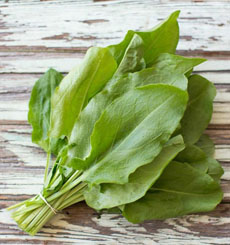TIP OF THE DAY: Make A Yogurt Moat For A Salad, With Sorrel
|
There are two ideas in today’s tip: In the photo, the chef piled a salad on top of a moat of garlicky sheep’s milk yogurt. The salad, which emphasizes different colors, is served for brunch or lunch with : It may be “just salad and yogurt,” but it has panache. The restaurant serves it with garlic toast and poached eggs. *Arugula’s sharp, pepper taste contrasts with sorrel’s tart, lemony flavor. Sorrel (SAW-rull) is not one of the most often-used herbs in the U.S., but it is a favorite worldwide. Common sorrel or garden sorrel—simply called sorrel—is a dark green (Rumex acetosa, photo #2) or variegated (photo #2) perennial herb. It’s a member of the Polygonaceae family, which includes buckwheat and rhubarb. Sorrel grows from early spring to late fall, but gets progressively more bitter as the months progress (a boon to those who like bitter herbs, but if it’s too bitter for you, simply blanch it). The plant has been cultivated for centuries. When the leaves are consumed raw they have a slight sour taste, due to oxalic acid. The tartness is enjoyed by many cultures. |
 Salad atop a “yogurt moat” at Botanica | LA.  Sorre[/caption] Sorre[/caption][2] Common sorrel (photo courtesy Good Eggs).
|
|
|
The oxalic acid in sorrel helps to cut through fatty or oily dishes. The next time you see fresh sorrel, pick up a bunch and experiment: Use some in a salad, some in a cooked dish. Sorrel is a “heart-healthy herb”—high potassium content, which lowers blood pressure and increases blood circulation. It is also loaded with antioxidant vitamins A and C. Sorrel, the herb, is not related to sorrel, the Caribbean drink. The later is made with hibiscus. |
||



